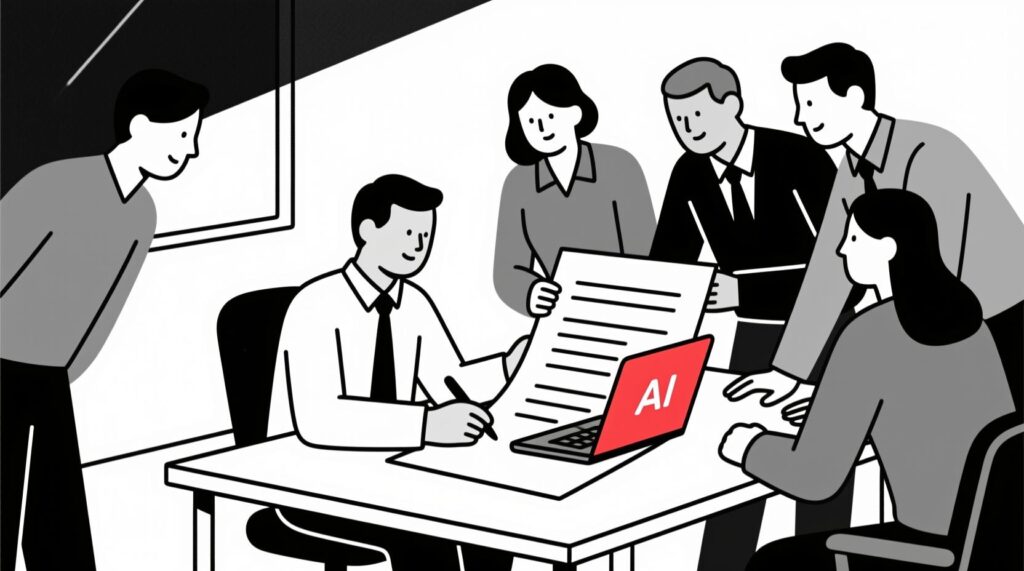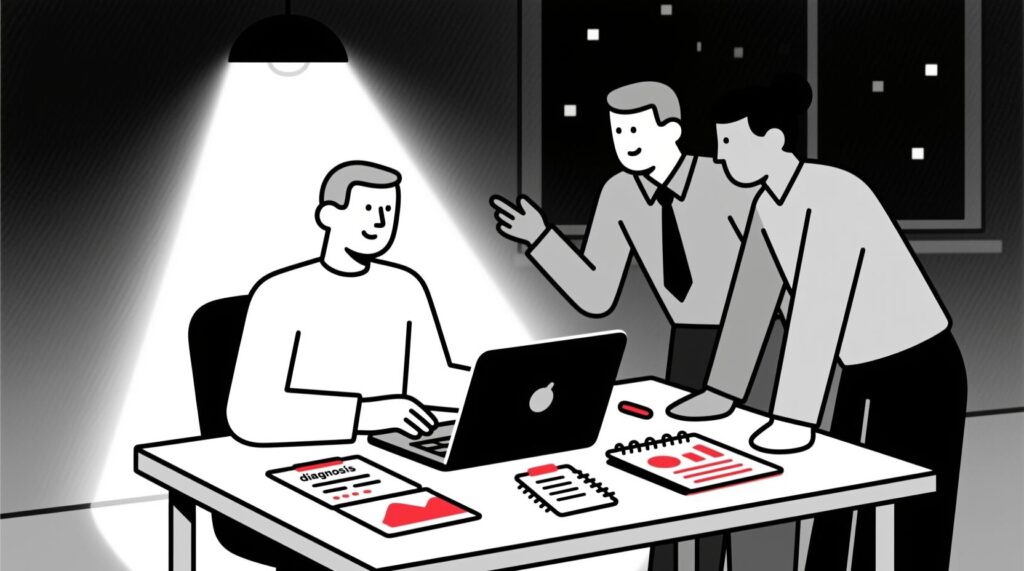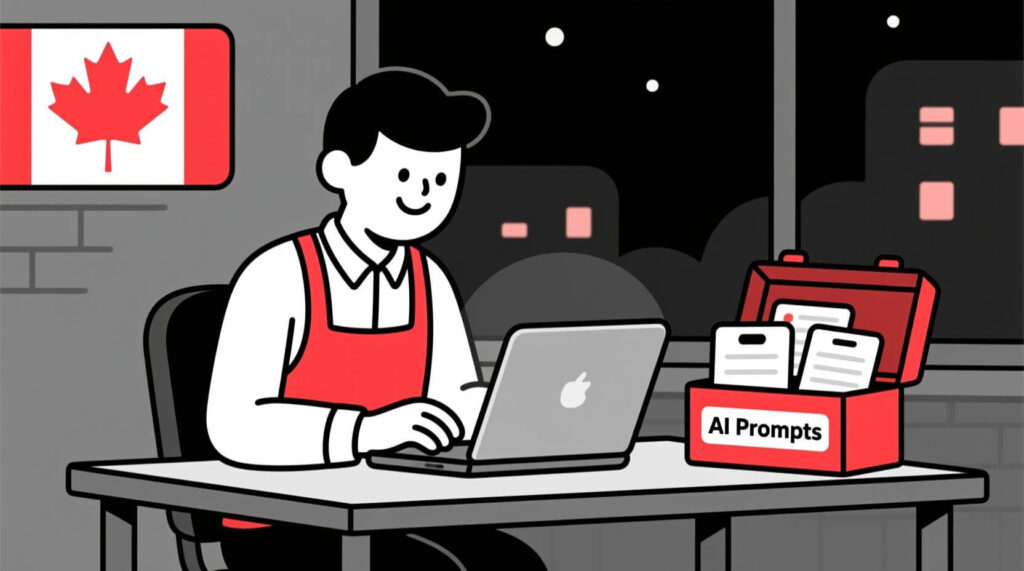
You became a non-profit leader to change the world, not to drown in paperwork. But the daily reality is a constant battle against the “tyranny of the urgent,” a relentless cycle of fire-fighting that leaves no room for the very thing your organization needs most: your vision.
If this feels familiar, you’re not alone. Research from Imagine Canada shows that 72% of non-profit leaders cite a ‘lack of time’ as the #1 barrier to strategic work.
The last six articles in this series have been about using your AI co-pilot to systematically buy back your time. Now, it’s time to cash in that dividend. We’re going to invest the time you’ve reclaimed to build your organization’s most powerful asset: its Strategic Narrative.
A strategic plan isn’t a dusty binder on a shelf. It’s the clear, compelling story of where you are, where you’re going, and how you’ll get there. This guide provides a lean, AI-powered framework to help you write that story.
The Strategic Narrative: Your Most Valuable Asset

Before we start, let’s be clear: making time for strategy is the fastest path to solving the problems that are stealing your time. The data is unequivocal:
- It’s a fundraising power tool, leading to 30% higher revenue.
- It’s a resilience shield, making you 25% more likely to survive funding shortfalls.
- It’s a board alignment magnet, creating a 40% increase in mission clarity.
Your strategic narrative is the story that secures grants, inspires your team, and aligns your board. Let’s use AI to build it.
The AI-Powered Strategic Sprint: A Lean, 3-Part Framework

Part 1: The Diagnosis (The Raw Materials for Your Story)
A great story starts with understanding the landscape. AI can act as your unbiased analyst to give you a clear-eyed view of your reality.
A) The AI-Facilitated SWOT Analysis This is the foundational step that 85% of small non-profits skip. Don’t be one of them.
Your “SWOT Facilitator” Prompt:
"Act as a non-profit strategic planning facilitator. I need to conduct a SWOT analysis for my organization, a [describe your non-profit]. I will provide my raw thoughts. Your task is to organize them, identify connections between the categories, and rephrase them in professional language for a strategic plan. Here are my notes: [Paste your raw notes on Strengths, Weaknesses, Opportunities, Threats]."B) The AI Data-to-Insight Engine Only 12% of Canadian non-profits regularly use their own data to inform strategy. This is your new superpower. Feed your raw, anonymized data to the AI.
Your “Data Analyst” Prompts:
- For Fundraising Data:
"Analyze our fundraising data below. Identify our most valuable donor segment, our most effective campaign, and the biggest opportunity for growth."- For Program Data:
"Analyze our program data below. Identify which program has the highest impact for the lowest cost, where we have the longest wait times, and a key trend in the needs of the people we serve."- For Community Feedback:
"Analyze the qualitative feedback from our recent community survey below. What are the top 3 things our community values most about us, and what is the single biggest frustration or unmet need they mentioned?"Part 2: The Visioning & Reality Check (Writing & Stress-Testing the Plot)
Now, let’s set a course for the future and anticipate the obstacles.
A) The AI-Powered Goal Setting Translate your insights into a clear, motivating direction.
Your “SMART Goals” Prompt:
"Act as a strategic planning expert. My high-level goal is to 'increase our community impact.' Based on our mission and the insights from our SWOT and data analysis, help me break this down into three specific, measurable, achievable, relevant, and time-bound (SMART) goals. For each goal, suggest one key performance indicator (KPI)."B) The AI-Powered “Pre-Mortem” Analysis (Your Secret Weapon) This is how you build a resilient strategy. Imagine your plan has failed spectacularly a year from now, then ask the AI to help you figure out why.
Your “Pre-Mortem” Prompt:
"Act as a risk management consultant. We have just set three new strategic goals for the next year: [List your 3 SMART goals]. I want to run a 'pre-mortem' exercise. Based on these goals, please brainstorm a list of the top 5-7 potential reasons this strategic plan could fail. Think about internal factors (like staff burnout, lack of resources) and external factors (like a change in government funding, a new competitor)."Part 3: The AI-Powered Action Plan (The Chapter Outline)
Finally, turn your goals into a concrete, one-page action plan your team can actually use.
Your “Action Plan” Prompt:
"Act as a project manager. I have defined three strategic goals. Please turn them into a simple action plan table with these columns: 'Strategic Goal,' 'Key Initiative,' 'Quarterly Milestone (Q1-Q4),' 'Owner,' and 'KPI.' Here are the goals: [Paste your 3 SMART goals here]."Canadian AI Guy’s Pro Tip: Your AI Strategic Command Centre
Here are the essential prompts from this playbook. Save these—this is your new toolkit.
1. The SWOT Facilitator:
"Act as a strategic facilitator. Organize, connect, and professionalize my raw SWOT analysis notes: [Paste notes]."2. The Data Analyst:
"Act as a data analyst. Analyze my [fundraising/program/feedback] data and identify 3 potential strategic insights. Data: [Paste raw data]."3. The Goal Setter:
"Act as a strategic planning expert. Help me break down my vague goal '[vague goal]' into 3 SMART goals with KPIs, based on our mission."4. The Pre-Mortem Analyst:
"Act as a risk management consultant. Run a 'pre-mortem' on our new strategic goals: [List goals]. Brainstorm the top 5-7 potential reasons this plan could fail."5. The Action Planner:
"Act as a project manager. Turn my 3 strategic goals into a one-page action plan table with columns for Goal, Initiative, Milestones, Owner, and KPI. Goals: [Paste goals]."Conclusion: From Chief Doer to Chief Visionary

This AI-powered sprint isn’t just another task. It’s the payoff.
All the time you’ve saved has led to this moment: the moment you have the space to rise above the daily chaos and lead. AI is the tool that can finally break the “tyranny of the urgent.” It automates the administrative burden, freeing you up to do the visionary work you were hired to do.
You can now move from being the organization’s chief “doer” to its chief thinker and the architect of its future. The next chapter of your mission is not found in your inbox; it’s found in the quiet moments of deep thinking that you have just earned back.Your Challenge: Block two hours on your calendar this week. Call it “Strategic Thinking Time.” Use the AI diagnosis prompts and just begin the conversation.
Canadian AI Guy’s Pro Tip: A great plan needs a great rollout. Our AI for Leaders coaching program is designed to help you not only build your strategic plan but also communicate your new Strategic Narrative effectively to your board, staff, and funders, ensuring everyone is inspired and aligned for the journey ahead.
People Also Ask
1. Is a strategic plan created with AI as “valid” as one from a consultant?
Think of AI as the world’s best facilitator and analyst, not the final decision-maker. It helps you structure your own team’s thoughts and data, which often leads to a plan with more internal buy-in than one created by an external consultant. The wisdom is still yours; the AI just organizes it.
2. How can I get my board and team to buy into this AI-assisted process?
Frame it as a tool for efficiency and deeper insight. Say, “We’re going to use an AI partner to handle the data analysis and document drafting, so we can spend our precious time together having the high-level strategic conversation that truly matters.”
3. Can AI help me conduct an “environmental scan” of trends affecting my non-profit?
Absolutely. Use a prompt like:
"Act as a futurist for the Canadian non-profit sector. What are the top 5 social, technological, and economic trends that a [your type of non-profit] should be paying attention to over the next three years?"4. What’s the best way to present AI-generated data insights to a skeptical board?
Be transparent, but lead with the insight, not the tool. Say, “I was analyzing our program data, and an interesting pattern emerged…” Then, if asked how you found it, you can explain, “I used an AI tool to help me quickly analyze the raw numbers, which highlighted this trend for us to discuss.”
5. How often should we review and update our AI-assisted strategic plan?
A strategic plan should be a living document. Use AI to help you prepare for a quarterly strategic check-in meeting with your board and senior leaders to review progress against your KPIs and make adjustments as needed.


